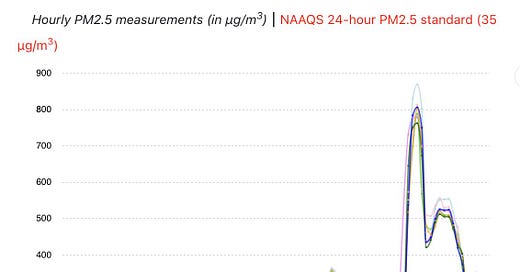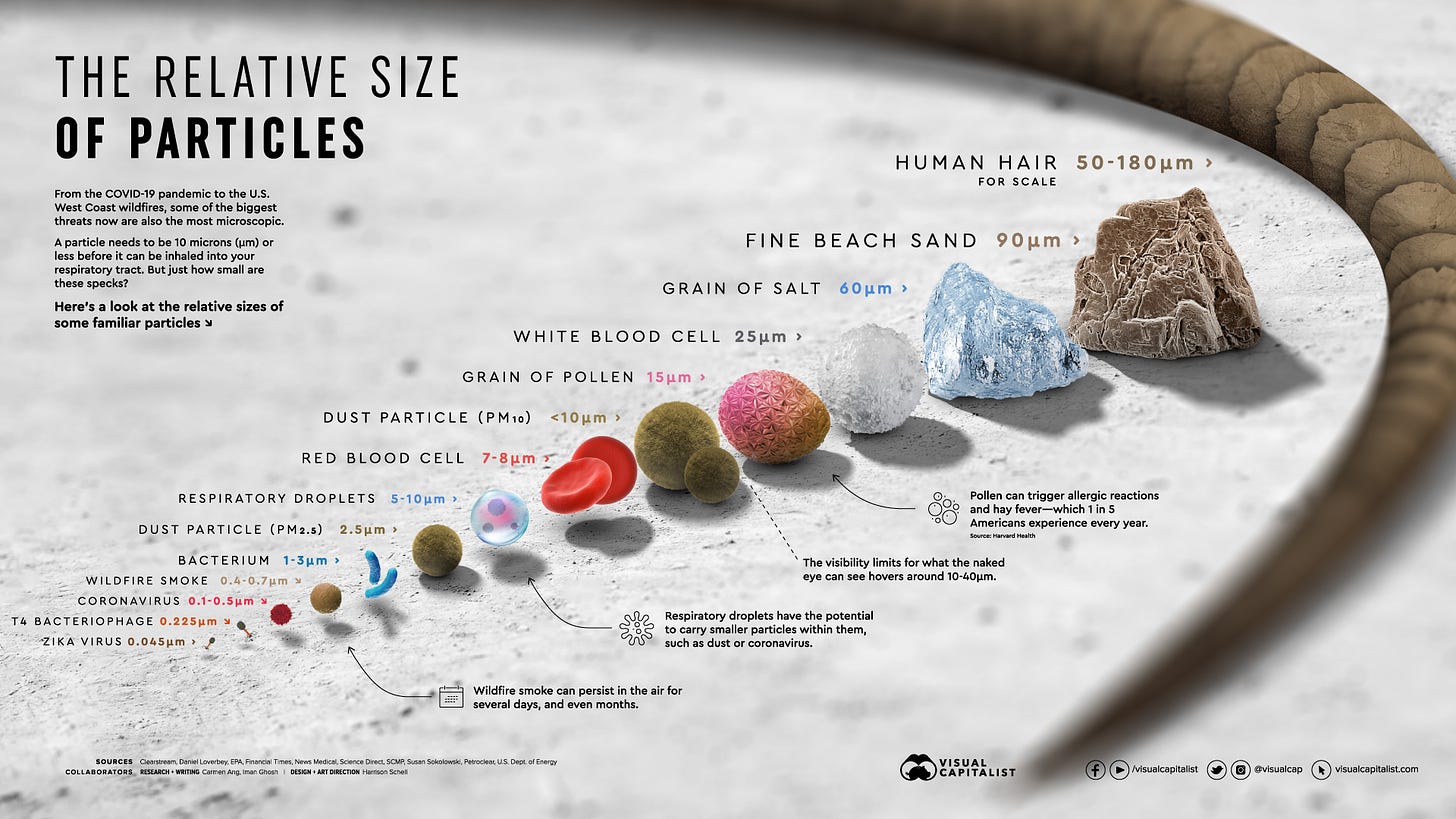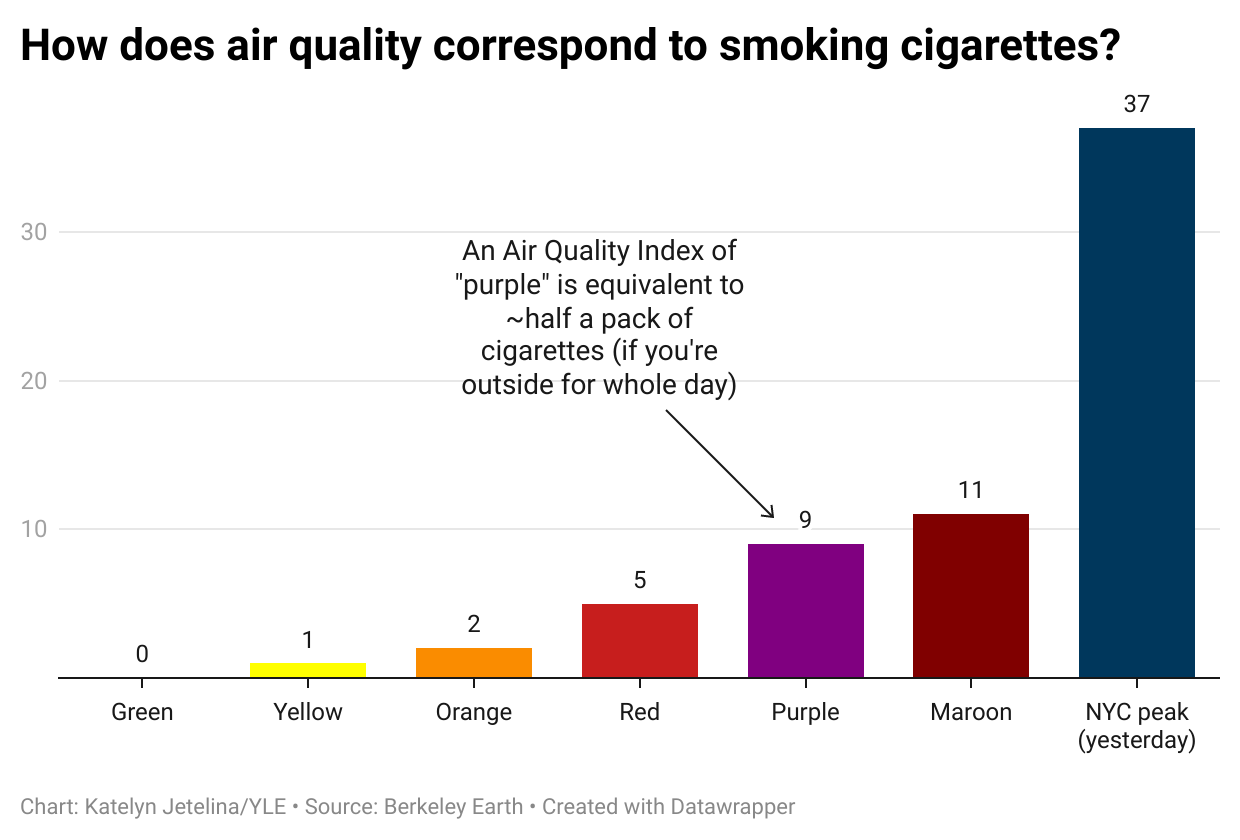Watching wildfire smoke blanket the Northeast U.S. and parts of Canada over the past few days has been surreal. Air quality is impacted for tens of millions of people, with off the charts pollutant levels in some areas.
I can’t help but notice striking comparisons with this public health problem to another— the pandemic.
Oh …those things called masks
Given wildfire smoke and respiratory droplets are larger than N95’s filtration efficiencies, this means masks work for both.
I’ve heard that more people are wearing masks in the past two days than I did last winter when COVID, RSV, and flu blanketed communities. I chalk this up to three things:
Visible vs. invisible threats. When something is invisible, it’s much more difficult to act. This has long been a menace to public health. Would masking during winter be different if viruses created green plumes of smoke? Tools that make viruses as visible as smoke, like perhaps a viral load indicator on weather apps, could be low-hanging fruit.
Immediate vs delayed effect. Symptoms from smoke are pretty immediate (i.e., watery eyes, coughing). Symptoms from viruses are delayed (takes a few days to replicate in your body). And, in some cases, the immune system will prevent infection or symptoms altogether. So, the causal relationship is less apparent to people.
Novel vs. familiar threat. COVID-19 is not novel anymore; the majority of people have become more comfortable placing its risk among our normal repertoire of threats. Wildfire smoke in the Northeast is novel. Would the same number of people be wearing a mask after 3.5 years of wildfire smoke?
Politicization is on full display… again
It didn’t take long for the politicization of public health and climate change to be on full display with wildfire smoke. Just like with the pandemic, this is gravely dangerous to the health of communities.
One national news station pushed the idea that there are no health harms with wildfire smoke and masks don’t work. That’s just plain wrong. As one epidemiologist said during the pandemic, “Politicizing masks makes as much sense as politicizing gravity.”
Risk communication is key
Clear, timely risk communication is important so people can make evidence-based decisions today. We did this terribly during the pandemic. It was better with smoke.
With a novel threat, like wildfire smoke, it’s best to compare to harms we do know—like cigarettes. This helps gauge risk more accurately. For example, thanks to data from Berkeley Earth, I found breathing in excessive amounts of wildfire smoke (rated “purple” on the Air Quality Index scale) is equivalent to smoking half a pack of cigarettes. Time to wear that mask?
Signs of climate change
Contrary to a few nasty emails I received after my last post, yes… climate change is a problem. Both viruses and wildfires put this on full display:
Smoke: An estimated 82 million Americans will experience a 57% increase in frequency and a 31% increase in the intensity of “smoke waves”—2 or more consecutive days with high wildfire-specific PM2.5—in years to come. Northern California, Western Oregon, and the Great Plains will suffer the most.
Viruses: Climate change is increasing the transmission of viruses. Animals and humans are moving to higher elevations, different biodiversity hotspots, and areas previously uninhabited. For example, mosquitos are migrating to new areas and, thus, introducing diseases to previously protected populations.
Importance of indoor air quality
Both events show that improving indoor air is a powerful mitigation tool that has been underutilized for decades. In addition, some of the best public health interventions are those happening in the background: institutional interventions that work passively and invisibly for the individual. Addressing indoor air in an equitable way is a massive challenge, and I hope we improve with time.
Bottom line
We need to be smarter and better adapt because the environment around us is rapidly changing. Our health depends on it, whether the threat comes from wildfires or viruses.
Love, YLE
“Your Local Epidemiologist (YLE)” is written by Dr. Katelyn Jetelina, MPH PhD—an epidemiologist, data scientist, wife, and mom of two little girls. During the day she works at a nonpartisan health policy think tank and is a senior scientific consultant to a number of organizations, including the CDC. At night she writes this newsletter. Her main goal is to “translate” the ever-evolving public health science so that people will be well-equipped to make evidence-based decisions. This newsletter is free thanks to the generous support of fellow YLE community members. To support this effort, subscribe below:









Yep, and climate change is more than “a problem”: it, along with nuclear weapons, is going to destroy the basis for any kind of semi-decent organized society. Thing is, nukes have to be used—an act of commission. We have dodged that, often out of sheer luck, for 80 years. Our luck will run out sooner or later.
With carbon, we have to do something to stop it. An act of commission to stop it. It’s not going well.
Of course, if unchecked, climate chaos will lead to resource wars. Example: as the Himalayan glacier-river system tanks, do you think India and Pakistan will sit down and nobly divvy up the starvation proportionally? They have almost come to nuclear blows a couple of times over nationalist idiocy, mostly.
Studies of a full exchange have been done: the fires even of a small nuclear war—couple hundred bombs—throws up enough soot to kill photosynthesis, effectively—at least human agriculture—for 2-3 years. Billions starve—it’s a total catastrophe. The end of civilization.
That’s the future if we don’t act now. Physically guaranteed.
The joke is that this reality is so dire, everyone feels what you, Dear Reader, are feeling right now: “I don’t want to believe it.” Because the second you do—really believe it—you’re on the moral hook to do something about it, especially if you have kids.
This is why the right won on Covid and why it will win, period. They offer total escape from responsibility into a solipsistic fantasyland, complete with not just comforting delusions but also highly useful targets for organized sadism, enemies at home and abroad who will be blamed as things fall apart.
Cuz these yahoos are going to floor carbon. They will solve no problems, take no responsibility or blame.
Just like most of us, I fear.
But I plan to continue doing what you and most on here do: see dire reality, have the guts not to deny it, take the responsibility, and never shirk from laying it out even though Cassandras don’t get treated well.
Go down, if we are to, with your values intact. Not on your knees. It’s why I support this Substack. Keep playing the game properly even if there are few in the stadium, as it were.
Completely agree with the “three things” that got people to wear masks again. But I think you overlooked an important fourth one ( though it’s related to number 3) Temporary vs ( seemingly) permanent. Telling/asking/suggesting people do something for a very limited amount of time is WAY more palatable than a seemingly never ending situation ( or heaven forbid) constantly “moving the goal posts”. Novel vs familiar is a bit different. It suggests the shock of the new vs old hat. But temporary vs permanent plays on different parts of the human psyche.
Similarly…in a different situation….I think the message that was able to be given regarding Mpox ( make changes until you are vaccinated) was one of the reasons why you got a high degree of “buy in”.
A few days of masking til air quality improved ( there was lots of information out there that this would get better…and it has) is fundamentally different than an endless situation. But the immediate effects and visibility of the threat are still the most important.